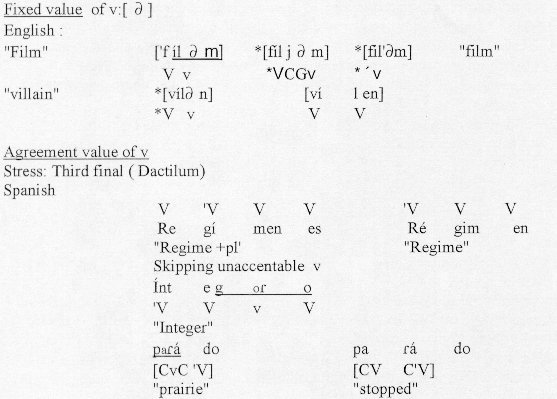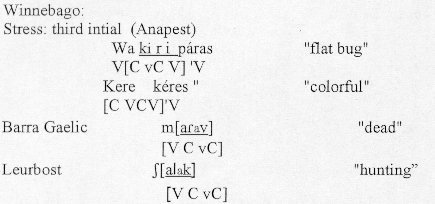
5.5 Overview of the svarabhakti Construction
This is a construction found in many languages such as Spanish (Quilis 1981, García-Bellido 1999), Barra Gaelic, Leurbust (Smith 1999), Winnebago (Hayes 1995) and English (Lass 1984:§8.4.1). Its components are shown in (33):
| (33) | |
 |
A Sonorant consonant (S) is surrounded by two vocoids VCV and the svarabhakti Vocoid v is surrounded by two
Consonantoids CvC. In some languages the interconsonantal svarabhakti must agree in Place of Articulation with the other Vocoid
(Spanish, Winnebago, Barra Gaelic, Leurbust), while in other languages (English) a svarabhakti appears in a non-agreeing form
(shwa  ). In some languages, like in Spanish, the peripheral C cannot be a Sonorant, while in others it can,
although in that case it cannot be a Liquid (English). Since they do not participate in stressed algorithms,
Svarabhakti vocoids are not accentable.1 Svarabhakti vocoids cannot be interrupted by other vocoids
interconsonantly. Some of these properties are exemplified in (34).
). In some languages, like in Spanish, the peripheral C cannot be a Sonorant, while in others it can,
although in that case it cannot be a Liquid (English). Since they do not participate in stressed algorithms,
Svarabhakti vocoids are not accentable.1 Svarabhakti vocoids cannot be interrupted by other vocoids
interconsonantly. Some of these properties are exemplified in (34).
| (34) | |
  |
The fact that children skip the two segments in the middle of the construction in their first stage (Eng. f[im]/Sp. [pa]do) indicates that putting together the main Predicate P1 with syntactic Arguments P(V) or P(V,V) is developmentally more feasible at an earlier stage than putting together two predicates: P2(P1 (A). More to the point, [V-C-V] [aRa] [aba] is integrated, stabilised and resolved as a flap and as an Obstruent respectively very early in language development. At a later stage putting together a P1(V) with a P2(V,V) becomes feasible when sharing an Argument, (24), is achieved [CVCV]. However the articulation of both Predicates using a different integration *[C-C-V ] *[pra] is not. Here two predicates do not combine with each other at a decompressed level. A bivalent Rhotic R(V,V) combining not syntactically with a monovalent Obstruent O(V) [C==RV] is articulatorily the same (a flap) but it is integrativily more complex because the two Predicates must integrate P2(P1) in a morphological compressed level where three Vocoids have to be reduced by compression to one V. Equally, if a bivalent Rhotic and a monovalent Obstruent are both operating at a morphosyntactic level, the stereo integration of the Rhotic has to be regulated to be expressed one argument morphosyntactically compressed R(v,V) while at the same time another argument has to be integrated not morphosyntactically compressed. Furthermore this morphosyntactic Argument has also to be integrated with two morphosyntactic elements v(C,C). The reciprocal embedding mechanism is a contractive operation occurring at a compression level which is not readily available from birth. This approach is coherent with the fact that children take longer in producing morphology than syntax. Under this view morphology and morphosyntax use for Arguments a compressed combinatorial and integrative process while syntax uses a decompressed combinatorial and integrative one. Putting together "I+ GO" [yo+voy] or "V V" is syntactic since the units [go] and [I] or V and V are both syntactic units in Spanish, while putting together "I + POST +GO" [Yo he de ir] or [ORV] is morphosyntactic or morphological because [he] or "R" is not a ysntactic unit but a morphemic unit under our test.
It would be important to know how these different compressive states are regulated.
1 This accentibility in metrical theory is recorded as projected vocoids or
moras on line 0 (Roca 1992). Some accentable Vocoids are accented because of their category: For instance in Spanish the last
accentable Vocoid of a Verb root (García-Bellido 1997:473) [a] in (7i) 'V, (19) is always accented if it can be expressed as
Vowel.
Volumen 22 (2005) ISSN: 1139-8736 |